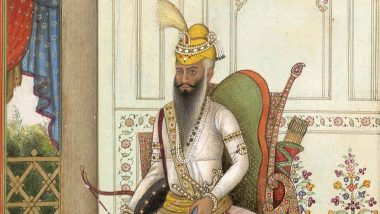New Delhi, June 28: Maharaja Ranjit Singh, the mighty Sikh ruler who led the Sikh empire in northwestern India for nearly four decades, had died on this day in the year 1839. Considered as one among the most powerful leaders of 19th century, his empire stretched from Kashmir on one end to Peshawar on another, and was headquartered in Amritsar-Lahore. Here are facts to know about Maharaja Ranjit Singh on his 181st death anniversary.
- Ranjit Singh was born on November 13, 1870, to Maha Singh Sukerchakia and Raj Kaur – the daughter of Raja Gajpat Singh of Jind. His place of birth was Gujranwala in Punjab - now lies in Pakistan.
- At the age of nine, he had contracted the lethal smallpox infection. Although Ranjit Singh survived, he lost vision in his left eye from the young age.
- When he turned 10, Ranjit Singh began participating in military battles alongside his father. Since his teenage years, he was considered as heir apparent to his father.
- After Ranjit Singh's father died, he drew credibility and praise from the military generals for his valour in the war to drive away invading Afghans.
- At the age of 21, he was declared as "Maharaja" and took over the reigns of Sikh empire. Ranjit Singh succeeded in uniting the the nearly dozen Sikh misls that were spread across the region of northwestern India.
- The Maharaja was known for drawing the goodwill of masses as he employed members of all faiths - Hindus, Muslims and Sikhs as well as European Christians - in his government.
- Ranjit Singh, according to historians, was strictly against smoking and eating beef. Those employed by his kingdom were reportedly instructed to adhere to this rule.
- The Maharaja's four-decade rule saw several major townships under his regime developing into centres of trade, arts and commerce. Some of the major cities under the then Sikh empire were: Srinagar, Attock, Peshawar, Bannu, Rawalpindi, Jammu, Gujrat, Sialkot, Kangra, Amritsar, Lahore and Multan.
- The religious tolerance policy was reflected by the diverse governance team of Ranjit Singh. His prime minister was Dhian Singh - a Dogra, foreign minister was Fakir Azizuddin - a Muslim and finance minister Dina Nath - a Brahmin.
- The Maharaja's health began declining since the onset of 1830s, and the complications increased over the next few years. On June 29, 1839, he died in mid-sleep. Four of his Hindu wives committed sati as an act of devotion, claim historians.
The empire of Ranjit Singh was, arguably, the strongest political kingdom to survive the onslaught of British East India Company in India in the early 19th century. After the Maharaja's demise, the colonial regime seized the opportunity arising out of internal divisions and misgovernance. The Anglo-Sikh wars led to the decline of Sikh empire and formation of British province of Punjab in 1849.
(The above story first appeared on LatestLY on Jun 29, 2020 07:29 AM IST. For more news and updates on politics, world, sports, entertainment and lifestyle, log on to our website latestly.com).













 Quickly
Quickly


